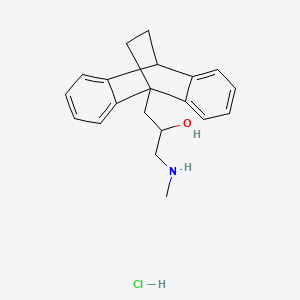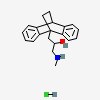Oxaprotiline Hydrochloride
PubChem CID
38206
Molecular Formula
Synonyms
- OXAPROTILINE HYDROCHLORIDE
- 39022-39-4
- Oxaprotiline HCl
- C-49802B-Ba
- Oxaprotiline hydrochloride [USAN]
Molecular Weight
329.9 g/mol
Computed by PubChem 2.2 (PubChem release 2021.10.14)
Parent Compound
Component Compounds
Dates
- Create:2005-08-08
- Modify:2025-01-04
Chemical Structure Depiction

3D Conformer of Parent
1-(methylamino)-3-(1-tetracyclo[6.6.2.02,7.09,14]hexadeca-2,4,6,9,11,13-hexaenyl)propan-2-ol;hydrochloride
Computed by Lexichem TK 2.7.0 (PubChem release 2021.10.14)
InChI=1S/C20H23NO.ClH/c1-21-13-14(22)12-20-11-10-15(16-6-2-4-8-18(16)20)17-7-3-5-9-19(17)20;/h2-9,14-15,21-22H,10-13H2,1H3;1H
Computed by InChI 1.0.6 (PubChem release 2021.10.14)
MUOSVLIKDZRWMP-UHFFFAOYSA-N
Computed by InChI 1.0.6 (PubChem release 2021.10.14)
CNCC(CC12CCC(C3=CC=CC=C31)C4=CC=CC=C24)O.Cl
Computed by OEChem 2.3.0 (PubChem release 2024.12.12)
C20H24ClNO
Computed by PubChem 2.2 (PubChem release 2021.10.14)
56433-44-4 (Parent)
- C 49802B-Ba
- C-49802B-Ba
- CGP 12103A
- CGP 12104A
- hydroxymaprotilin
- hydroxymaprotilin hydrochloride
- hydroxymaprotilin hydrochloride, (R)-isomer
- hydroxymaprotilin hydrochloride, (S)-isomer
- hydroxymaprotilin, (+-)-isomer
- hydroxymaprotilin, (+R)-isomer
- hydroxymaprotilin, (S)-isomer
- levoprotiline
- oxaprotiline
- OXAPROTILINE HYDROCHLORIDE
- 39022-39-4
- Oxaprotiline HCl
- C-49802B-Ba
- Oxaprotiline hydrochloride [USAN]
- NSC-310406
- UNII-9DOW99I129
- C 49802B-Ba
- 9DOW99I129
- Oxaprotiline hydrochloride (USAN)
- EINECS 254-249-7
- NSC 310406
- alpha-[(methylamino)methyl]-9,10-ethanoanthracene-9(10H)-ethanol hydrochloride
- OXAPROTILINE HYDROCHLORIDE [MART.]
- OXAPROTILINE HYDROCHLORIDE [WHO-DD]
- 9,10-Ethanoanthracene-9(10H)-ethanol, alpha-((methylamino)methyl)-, hydrochloride, (+-)-
- (+/-)-.ALPHA.-((METHYLAMINO)METHYL)-9,10-ETHANOANTHRACENE-9(10H)-ETHANOL HYDROCHLORIDE
- 1-(methylamino)-3-(1-tetracyclo[6.6.2.02,7.09,14]hexadeca-2,4,6,9,11,13-hexaenyl)propan-2-ol;hydrochloride
- 9,10-ETHANOANTHRACENE-9(10H)-ETHANOL, .ALPHA.-((METHYLAMINO)METHYL)-, HYDROCHLORIDE, (+/-)-
- OXAPROTILINE HYDROCHLORIDE (MART.)
- alpha-((Methylamino)methyl)-9,10-ethanoanthracene-9(10H)-ethanol hydrochloride
- SCHEMBL122886
- CHEMBL3989748
- C 49-802 BDA
- NSC310406
- AKOS027382008
- (+-)-alpha-((Methylamino)methyl)-9,10-ethanoanthracene-9(10H)-ethanol hydrochloride
- NS00057589
- D05284
- Q27272406
- (+/-)-ALPHA-((METHYLAMINO)METHYL)-9,10-ETHANOANTHRACENE-9(10H)-ETHANOL HYDROCHLORIDE
- 9,10-ETHANOANTHRACENE-9(10H)-ETHANOL, ALPHA-((METHYLAMINO)METHYL)-, HYDROCHLORIDE, (+/-)-
Property Name
Property Value
Reference
Property Name
Molecular Weight
Property Value
329.9 g/mol
Reference
Computed by PubChem 2.2 (PubChem release 2021.10.14)
Property Name
Hydrogen Bond Donor Count
Property Value
3
Reference
Computed by Cactvs 3.4.8.18 (PubChem release 2021.10.14)
Property Name
Hydrogen Bond Acceptor Count
Property Value
2
Reference
Computed by Cactvs 3.4.8.18 (PubChem release 2021.10.14)
Property Name
Rotatable Bond Count
Property Value
4
Reference
Computed by Cactvs 3.4.8.18 (PubChem release 2021.10.14)
Property Name
Exact Mass
Property Value
329.1546421 Da
Reference
Computed by PubChem 2.2 (PubChem release 2021.10.14)
Property Name
Monoisotopic Mass
Property Value
329.1546421 Da
Reference
Computed by PubChem 2.2 (PubChem release 2021.10.14)
Property Name
Topological Polar Surface Area
Property Value
32.3 Ų
Reference
Computed by Cactvs 3.4.8.18 (PubChem release 2021.10.14)
Property Name
Heavy Atom Count
Property Value
23
Reference
Computed by PubChem
Property Name
Formal Charge
Property Value
0
Reference
Computed by PubChem
Property Name
Complexity
Property Value
371
Reference
Computed by Cactvs 3.4.8.18 (PubChem release 2021.10.14)
Property Name
Isotope Atom Count
Property Value
0
Reference
Computed by PubChem
Property Name
Defined Atom Stereocenter Count
Property Value
0
Reference
Computed by PubChem
Property Name
Undefined Atom Stereocenter Count
Property Value
1
Reference
Computed by PubChem
Property Name
Defined Bond Stereocenter Count
Property Value
0
Reference
Computed by PubChem
Property Name
Undefined Bond Stereocenter Count
Property Value
0
Reference
Computed by PubChem
Property Name
Covalently-Bonded Unit Count
Property Value
2
Reference
Computed by PubChem
Property Name
Compound Is Canonicalized
Property Value
Yes
Reference
Computed by PubChem (release 2021.10.14)
Follow these links to do a live 2D search or do a live 3D search for this compound, sorted by annotation score. This section is deprecated (see here for details), but these live search links provide equivalent functionality to the table that was previously shown here.
Same Connectivity Count
Same Parent, Connectivity Count
Same Parent, Stereo Count
Same Parent, Isotope Count
Same Parent, Exact Count
Mixtures, Components, and Neutralized Forms Count
Similar Compounds (2D)
Similar Conformers (3D)
Same Count
Gene Count
Antidepressive Agents
Mood-stimulating drugs used primarily in the treatment of affective disorders and related conditions. Several MONOAMINE OXIDASE INHIBITORS are useful as antidepressants apparently as a long-term consequence of their modulation of catecholamine levels. The tricyclic compounds useful as antidepressive agents (ANTIDEPRESSIVE AGENTS, TRICYCLIC) also appear to act through brain catecholamine systems. A third group (ANTIDEPRESSIVE AGENTS, SECOND-GENERATION) is a diverse group of drugs including some that act specifically on serotonergic systems. (See all compounds classified as Antidepressive Agents.)
Patents are available for this chemical structure:
https://patentscope.wipo.int/search/en/result.jsf?inchikey=MUOSVLIKDZRWMP-UHFFFAOYSA-N
- CAS Common ChemistryLICENSEThe data from CAS Common Chemistry is provided under a CC-BY-NC 4.0 license, unless otherwise stated.https://creativecommons.org/licenses/by-nc/4.0/9,10-Ethanoanthracene-9(10H)-ethanol, α-[(methylamino)methyl]-, hydrochloride (1:1)https://commonchemistry.cas.org/detail?cas_rn=39022-39-4
- ChemIDplusOxaprotiline hydrochloride [USAN]https://pubchem.ncbi.nlm.nih.gov/substance/?source=chemidplus&sourceid=0039022394ChemIDplus Chemical Information Classificationhttps://pubchem.ncbi.nlm.nih.gov/source/ChemIDplus
- DTP/NCILICENSEUnless otherwise indicated, all text within NCI products is free of copyright and may be reused without our permission. Credit the National Cancer Institute as the source.https://www.cancer.gov/policies/copyright-reuse
- European Chemicals Agency (ECHA)LICENSEUse of the information, documents and data from the ECHA website is subject to the terms and conditions of this Legal Notice, and subject to other binding limitations provided for under applicable law, the information, documents and data made available on the ECHA website may be reproduced, distributed and/or used, totally or in part, for non-commercial purposes provided that ECHA is acknowledged as the source: "Source: European Chemicals Agency, http://echa.europa.eu/". Such acknowledgement must be included in each copy of the material. ECHA permits and encourages organisations and individuals to create links to the ECHA website under the following cumulative conditions: Links can only be made to webpages that provide a link to the Legal Notice page.https://echa.europa.eu/web/guest/legal-noticeα-[(methylamino)methyl]-9,10-ethanoanthracene-9(10H)-ethanol hydrochloridehttps://echa.europa.eu/substance-information/-/substanceinfo/100.049.300
- FDA Global Substance Registration System (GSRS)LICENSEUnless otherwise noted, the contents of the FDA website (www.fda.gov), both text and graphics, are not copyrighted. They are in the public domain and may be republished, reprinted and otherwise used freely by anyone without the need to obtain permission from FDA. Credit to the U.S. Food and Drug Administration as the source is appreciated but not required.https://www.fda.gov/about-fda/about-website/website-policies#linkingOXAPROTILINE HYDROCHLORIDEhttps://gsrs.ncats.nih.gov/ginas/app/beta/substances/9DOW99I129
- ChEMBLLICENSEAccess to the web interface of ChEMBL is made under the EBI's Terms of Use (http://www.ebi.ac.uk/Information/termsofuse.html). The ChEMBL data is made available on a Creative Commons Attribution-Share Alike 3.0 Unported License (http://creativecommons.org/licenses/by-sa/3.0/).http://www.ebi.ac.uk/Information/termsofuse.html
- KEGGLICENSEAcademic users may freely use the KEGG website. Non-academic use of KEGG generally requires a commercial licensehttps://www.kegg.jp/kegg/legal.htmlTarget-based classification of drugshttp://www.genome.jp/kegg-bin/get_htext?br08310.keg
- NCI Thesaurus (NCIt)LICENSEUnless otherwise indicated, all text within NCI products is free of copyright and may be reused without our permission. Credit the National Cancer Institute as the source.https://www.cancer.gov/policies/copyright-reuseNCI Thesaurushttps://ncit.nci.nih.gov
- Springer Nature
- Wikidataoxaprotiline hydrochloridehttps://www.wikidata.org/wiki/Q27272406
- PubChem
- Medical Subject Headings (MeSH)LICENSEWorks produced by the U.S. government are not subject to copyright protection in the United States. Any such works found on National Library of Medicine (NLM) Web sites may be freely used or reproduced without permission in the U.S.https://www.nlm.nih.gov/copyright.htmlhydroxymaprotilinhttps://www.ncbi.nlm.nih.gov/mesh/67027299Antidepressive Agentshttps://www.ncbi.nlm.nih.gov/mesh/68000928
- NORMAN Suspect List ExchangeLICENSEData: CC-BY 4.0; Code (hosted by ECI, LCSB): Artistic-2.0https://creativecommons.org/licenses/by/4.0/NORMAN Suspect List Exchange Classificationhttps://www.norman-network.com/nds/SLE/
- MolGenieMolGenie Organic Chemistry Ontologyhttps://github.com/MolGenie/ontology/
- PATENTSCOPE (WIPO)SID 389153092https://pubchem.ncbi.nlm.nih.gov/substance/389153092
CONTENTS


 CID 38207 (Oxaprotiline)
CID 38207 (Oxaprotiline) CID 313 (Hydrochloric Acid)
CID 313 (Hydrochloric Acid)